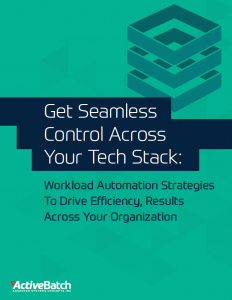IT teams spend an average of 44% of their time completing manual tasks just to keep the lights on, according to a study by Dynatrace. That figure isn’t expected to improve, as 70% of CIOs involved in the study expect cloud services will (ironically) lead to more manual tasks and routine maintenance.
This is a complexity problem, at its root.
There are plenty of automation products on the market to replace manual processes. But many of these products are point solutions designed for specific vendors (Azure, SAP, AWS), or for specific tasks such as data entry. As a result, you can have a dozen automation tools and not a single one that readily integrates with anything else.
As an alternative, there are automation platforms that provide a wide range of capabilities, along with direct integrations and API adapters, that make it possible to manage almost any automated process from a single location, as well as the infrastructure —on-prem or in any cloud— that those processes rely on.
Centralizing your automation environment can mean a couple of things. For example, say we have a car that pairs each wheel to its own engine. Managing those engines separately would make it virtually impossible to drive the car. Instead, you could replace those separate engines with a single, central engine, or tie those engines together under the (figurative and literal) hood, so that they can be controlled from a central location —your dashboard.
Centralization reduces IT complexity by enabling IT to manage automated processes and tools from a single location, making it possible to manage alerts, troubleshoot issues, and monitor environments from one platform, instead of several. This in turn enables IT to more efficiently manage day-to-day operations, while increasing reliability and improving SLAs. Plus, with less complexity and more connectivity, IT teams can rapidly automate time-consuming manual tasks.
Let’s take a closer look at how IT can simplify operations with a central automation platform.
(The following is an excerpt from our latest ebook, “Get Seamless Control Across Your Tech Stack.”)
Improve Visibility
By centralizing control over automated processes, your team will be able to gain deeper visibility into your automation environment. This includes monitoring resource usage to identify bottlenecks and improve performance, as well as using Gantt views to track process executions and identify delays. Additionally, reporting can be used to deliver actionable insights into processes and workloads.
As for troubleshooting, instead of digging through different logs for multiple point solutions, your IT team will have one central repository for logs.
Monitor In Real-Time
Real-time monitoring can be used to support auto-remediation for failed processes, as well as pre-emptive actions to prevent failures, delays, and overruns. This can include rerouting processes through different servers, provisioning additional resources, or reserving additional resources for critical tasks.
The more your team is able to centralize its automation, the easier it will be to monitor processes end-to-end. This in turn can drastically reduce your mean time to resolution (MTTR), saving your team valuable time while improving SLAs.
Additionally, real-time monitoring can be used to establish an effective alerting policy. Alerts can be triggered by job delays or failures, or when thresholds are met, allowing your staff to act quickly. Alerts can be sent via email, text messages, or even social media.
Automate Maintenance
Cloud-based services and platforms can be beneficial because the vendor handles updates and maintenance. But not every organization can route sensitive processes through third-party data centers. In this case, a self-healing on-premises automation platform can be implemented. Vendors are introducing pre-emptive error detection, sending users alerts when a potential conflict is anticipated, while optimization options are being provided based on environmental analyses, and can be deployed with a single click.
Access From Anywhere
Processes are running 24/7, so your team should have 24/7 access to critical environments. Mobile applications are available that provide secure access to automation environments, enabling your team to rapidly respond to process failures and delays — no matter where they are.
Likewise, web consoles make it possible to manage your automation environment from any browser, so whether you’re working in the office or at your home, you can have the control needed to prevent issues from impacting SLAs.
Endless Use Cases, Endless Efficiencies
The right automation platform should enable your team to automate virtually anything from a single pane of glass, including:
- IT processes
- Business processes
- Managed file transfers
- Resource provisioning
- Data warehousing/ETL
- Big data
This makes it possible to not only simplify operations, but to streamline development. You can read the rest of the tactics and strategies for efficient automation environments in our latest ebook, “Get Seamless Control Of Your Entire Tech Stack: Workload Automation Strategies To Drive Efficiency, Results Across Your Organization.”
Don’t Settle For Unreliable Automation
Improve reliability and extensibility across your environment with the right workload automation strategies and tools.

